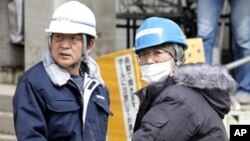On Wednesday, Panasonic, Fujitsu and NEC restarted electronics factories. But, as they were doing so, other companies were halting production, because of difficulty getting parts.
Sony stopped work at five factories, including those making television and cameras, because it cannot get raw materials or electronic components.
Toyota and Honda both say they will not resume car production until at least next week and the delay could be longer. Toyota spokesman Paul Nolasco explains why.
"We are having trouble setting up a smooth flowing and solid supply chain for electronics parts, for rubber parts and for plastic parts," Nolasco said.
Japan's big manufacturers have complex supply chains and disruption at any point can cause the entire system to stop.
Although quake or tsunami damage has directly hit some parts makers, others have been unable to distribute goods because of road closures in the quake-hit area and a shortage of gasoline across east Japan.
Those problems are showing signs of improvement.
The major Tohoku expressway, that runs from Tokyo through northern Japan, is now open to all trucks and the Petroleum Association of Japan says production of gasoline should be at 90 percent of normal levels by the end of this week.
The cost to businesses and the national economy is still difficult to gauge. The government says the direct cost of destruction of housing, businesses and infrastructure could be as high as $309 billion.
That figure does not include secondary losses, such as those caused by power shortages.
Tokyo Electric Power warned Wednesday that east Japan's current electricity problems could continue for months.
Peak demand for electricity on a hot day in the capital is 60 percent higher than the company can currently generate. The blackouts that have hit areas around Tokyo could extend to residential areas of the city itself.
The utility is short of electricity because 13 power stations remain offline ,and Fukushima Number 1, is likely never to come back online.
On Wednesday, Tokyo Electric asked seven banks for $25 billion to repair the damaged power plants.
Japanese Businesses Restart Production, But Problems Remain
